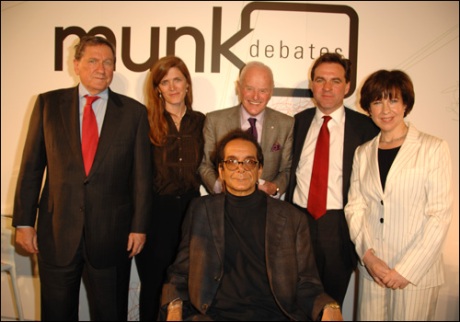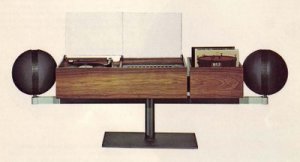Who doesn’t like a good, clean debate?
May 28, 2008
This past Monday, Toronto’s ROM hosted the inaugural edition of the Munk Debates, an event hosted by Peter Munk and his wife Melanie, and aimed at increasing the quality of public policy debate in Canada. While some were intrigued by the fact that the first debate centered around the US election and hosted no Canadian speakers, you can’t deny that these are still exciting times down south (for those of us who haven’t burnt out already) and it was probably smart to start with a hot topic.
The debate was technically about whether a Republican in the White House would make the world a safer place, but it ended up boiling down to Obama vs. McCain (even former diplomat Richard Holbrooke, an adviser to Hilary Clinton, didn’t really argue with the notion that his candidate’s dreams were dust).
And further, because it was a debate, those in attendance weren’t always witnessing the highest form of political discourse. I love Niall Ferguson the historian, but Niall Ferguson the debater is a bit of a cartoonish fear-monger. Though he made an excellent point about our need to pay more attention to China’s race for resources in Africa (and elsewhere), he spent much of the rest of the debate making wise-cracks and breathing fire-and-brimstone. Holbrooke, on the other side, spent much of his time winking at old political friends in the crowd and trying to flatter our minds into mush.
The two strongest players were no doubt Samantha Power and Charles Krauthammer; the former because she refused to abandon the subtlety of her arguments in the face of the boy’s school debating club atmosphere, and the latter because he made a clear, insightful, and high-minded case for having an experienced hand at the controls.
Before the debates, Peter Munk declared that he wanted an event that would shake people’s closely held opinions. It looks like he got his way. Where only 29% of attendees agreed with the idea that the safety of the world demands a Republican on the way in, 46% agreed on the way out.
I’m not sure whether that speaks to the power of Ferguson and Krauthammer’s debating skills, or to the fickle minds of those in attendance. You decide. Take a listen to the podcast of the event.
Lessons (and laughs) from the Odd Couple of business
May 11, 2008
The world (well, the Globe and Mail at least) is suddenly hot for Clairtone, Kickstart contributor Peter Munk and David Gilmour’s starburst of a hi-fi business from the 1960’s.
Since the release of Nina Munk and Rachel Gotlieb’s The Art of Clairtone, a book about the company’s remarkable design innovations in the heyday, Gordon Pitts has been running a series of excellent retrospective stories. This time, Pitts sits down with Munk and Gilmour 55 years after their relationship first blossomed, and asks them to comment on their longstanding friendship (Partnership is a lot like marriage — the financial stresses, all too close for comfort, the competitive nature,” Mr. Gilmour observes. Then he turns to his friend Mr. Munk and quips: “But in a marriage, at least there is sex to make it up.”), their past mistakes (Gilmour: “Chance favours those who are prepared. There are five elements to running a business — design, marketing plan, people, finance and production. When you are in your 20s, you can lose sight of those things. What Peter did brilliantly, after Clairtone, was that we always entered the next business with a flawless plan.”) and success (Munk: “I wouldn’t call Clairtone unsuccessful, because it achieved more than many more businesses that were classified as successful. It created products, it created a Canadian awareness. Finance isn’t the only criterion on which to judge a human activity.”) Give it a read.
The Lessons of Clairtone
April 18, 2008
Just when we expressed disappointment that a recent Globe and Mail profile on Peter Munk didn’t explore his halcyon days at Clairtone in the swinging sixties, today’s paper featured an excellent piece from Business writer Gordon Pitts on the just that very subject. More specifically (and quite interestingly)? The question: “Is there something in the Canadian psyche that militates against product development and marketing?” Are we doomed to be perpetual hewers of wood and drawers of water, timorous in any arena where design innovation is life?
Good question. And one we’ve been playing around with ever since we interviewed Munk two years ago.
Because the story of Clairtone ends rather badly, much of its history has been buried in the collective consciousness. My parents vaguely recall the company’s celebrated “Project G”, but when I show them the company’s cutting edge ads, it all comes tumbling back.
Here, you try. We’ve already shown one. Here’s another.
Pitts’ comparison to Apple may be a bit of a stretch, but when Munk and his business partner, David Gilmour, burst onto the scene, they represented an entrepreneurial vigour Canada hadn’t seen, perhaps ever. It was the ultimate coming together of technology and design, and the company’s advertising reflected this. The campaigns, designed by legendary political tactician Dalton Camp, pitched the two men as Trudeau-era saviours of corporate Canada.
As Pitt points out, though, the real star of the show was the Project G. You may remember it from such films as The Graduate (in one of the first instances of Hollywood product placement). It’s that stereo with the globe-shaped speakers in the famous seduction scene. The Ipod of its day, or almost.
After flying high and expanding into the US, Clairtone went from being an astonishing Canadian success story to a cataclysmic failure in a matter of years. The more minor “whys” differ depending on who you ask, but its clear that Munk wasn’t the most frugal of men and that the company sought to expand even as finances were pinched. It’s main mistake: it went after easy regional development funding in Nova Scotia, setting up factories for the manufacture of radios and TV in rural Stellarton and allowing politicians and local business people onto its board in lieu of industry experts. Then it tried to get into the automobile industry and one day found itself controlled by the provincial government of Nova Scotia. A significant woops to be sure.
Pitts’ piece explores all this history, but his core thesis pushes beyond the standard ‘shouldn’t have gone east’ line adopted by most. He actually suggests that despite its marketing verve and undeniable moxie, Clairtone was too timid.
“For all its bold design”, he writes, “it never stopped turning out clunky mainstream stereos encased in period furniture. Project G was actually a small part of the product line. It could be argued that Clairtone could only survive by catering to popular tastes. Yet Apple’s Steve Jobs has prospered by leading tastes, not by bending to those of the masses.”
It’s an interesting argument, and one that Pitts then segues into a brief discussion of Clairtone’s most recent progeny: Research in Motion. RIM appears in a far safer position than Clairtone ever did, partly due to its financial management, but also due to cultural changes whereby the commercialization of technology advance has gone more mainstream. Clairtone had to live by the seat of its pants for its entire life cycle in a country that hadn’t ever really seen its like before. That is changing now. But more slowly than it should.
If we want more Clairtone’s and RIMs – and we do – then we shouldn’t let the Munk and Gilmour story be forgotten.
For more on the design evolution of Clairtone, take a look at The Art of Clairtone, The Making of a Design Icon, a book that Munk’s daughter Nina has co-authored with design curator Rachel Gotlieb.
Peter Munk’s Golden Rule
April 15, 2008
Check out this piece in Saturday’s Globe and Mail Toronto section. It provides those who know little about the founder and Chairman of Barrick Gold with a nice summation of his myriad business peregrinations. Unfortunately, it gives little space to the heady days of Clairtone Sound Corp., the hi-fi company he founded with David Gilmour in the sixties (see Kickstart for more on that) or the controversies around Barrick’s mines in Africa. That said, it does include the hilarious details of his first days at Lawrence Park Collegiate high school in Toronto, especially the Hungarian immigrant’s appreciation of girl’s tight-fitting sweaters.
The reason for the article? Well, in addition to the thousand other things Munk has helped birth in the city of Toronto, he is now bringing a debating series. The inaugural throw-down (Munk actually compares what he wants to see occur to a cock fight) will feature Richard Holbrooke (former US ambassador to the UN), human rights scholar Samantha Power, star historian Niall Ferguson, and Washington Post columnist Charles Krauthammer. The topic: Whether a Republican in the White House makes the world safer. Munk’s ideological cock fight will go down on the 26th of May at the ROM’s Michael Lee-Chin Crystal. For info about the series and how to get tickets, click here.
Vintage Munk
February 14, 2008
Before he was the founder and Chairman of Barrick Gold, Kickstart participant Peter Munk was many things, one among them, the twenty-something co-founder of Clairtone Sound Corporation. In the sixties, Clairtone combined high-end stereo equipment with stylish Scandinavian cabinetry and avant-garde marketing. After surviving by the skin of its teeth for the first while, Clairtone became a whopping success and its two founders, Munk and David Gilmour, media stars. Eventually, the company moved into the competitive colour TV market. Here, from 1967, is the TV spot Young & Rubicam did for their G-TV. Gorgeously shot by Frank Spiess, it’s a perfect snapshot of Canadian optimism and new-found flash in what Pierre Berton called “the last good year”.


